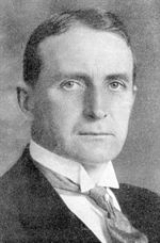
Bjorn Helland-Hansen
Encyclopedia
Bjørn Helland-Hansen was a Norwegian
pioneer in the field of modern oceanography
. He studied the variation patterns of the weather in the northern Atlantic Ocean
and of the atmosphere.
He developed the "Helland-Hansen Photometer
" in 1910, which was carried on board Michael Sars
. It was operated for the first time close to the Azores
at a depth between 500 and m. In 1915 he became Professor of oceanography in the University of Bergen
, and in 1917 director of the Geophysical Institute, University of Bergen
.
In 1933 he was awarded the Alexander Agassiz Medal
. In 1939 he became President of the International Geodesic
and Geophysical Union. He was a member of the Prussian Academy of Sciences
and a member of the Member of the Academy of Sciences of the German Democratic Republic
(DDR).
Helland-Hansen trained Alexander Kuchin
, the Russian oceanographer who went to Antarctica with Roald Amundsen
. An island in the Russian Arctic
, east of the Geiberg Islands
, has been named Gellanda-Gansena after Helland-Hansen.
Norway
Norway , officially the Kingdom of Norway, is a Nordic unitary constitutional monarchy whose territory comprises the western portion of the Scandinavian Peninsula, Jan Mayen, and the Arctic archipelago of Svalbard and Bouvet Island. Norway has a total area of and a population of about 4.9 million...
pioneer in the field of modern oceanography
Oceanography
Oceanography , also called oceanology or marine science, is the branch of Earth science that studies the ocean...
. He studied the variation patterns of the weather in the northern Atlantic Ocean
Atlantic Ocean
The Atlantic Ocean is the second-largest of the world's oceanic divisions. With a total area of about , it covers approximately 20% of the Earth's surface and about 26% of its water surface area...
and of the atmosphere.
He developed the "Helland-Hansen Photometer
Photometer
In its widest sense, a photometer is an instrument for measuring light intensity or optical properties of solutions or surfaces. Photometers are used to measure:*Illuminance*Irradiance*Light absorption*Scattering of light*Reflection of light*Fluorescence...
" in 1910, which was carried on board Michael Sars
Michael Sars
Michael Sars was a Norwegian theologian and biologist.-Biography:Sars was born in Bergen, Norway. He studied natural history and theology at Royal Frederick University from 1823 and completed a cand.theol. degree in 1828. For several years he taught at a number of different schools, firstly in...
. It was operated for the first time close to the Azores
Azores
The Archipelago of the Azores is composed of nine volcanic islands situated in the middle of the North Atlantic Ocean, and is located about west from Lisbon and about east from the east coast of North America. The islands, and their economic exclusion zone, form the Autonomous Region of the...
at a depth between 500 and m. In 1915 he became Professor of oceanography in the University of Bergen
University of Bergen
The University of Bergen is located in Bergen, Norway. Although founded as late as 1946, academic activity had taken place at Bergen Museum as far back as 1825. The university today serves more than 14,500 students...
, and in 1917 director of the Geophysical Institute, University of Bergen
Geophysical Institute, University of Bergen
Geophysical Institute, University of Bergen is a marine research facility located in Bergen, Norway. Founded in 1917 by Bjørn Helland-Hansen, the institute studies the field of oceanography dealing with the variation patterns of the weather in the North Atlantic Ocean off the coast of Norway....
.
In 1933 he was awarded the Alexander Agassiz Medal
Alexander Agassiz Medal
The Alexander Agassiz Medal is awarded by the U.S. National Academy of Sciences for an original contribution in the science of oceanography. It was established by Sir John Murray in honor of his friend Alexander Agassiz.-Recipients:-References:NotesA...
. In 1939 he became President of the International Geodesic
Geodesic
In mathematics, a geodesic is a generalization of the notion of a "straight line" to "curved spaces". In the presence of a Riemannian metric, geodesics are defined to be the shortest path between points in the space...
and Geophysical Union. He was a member of the Prussian Academy of Sciences
Prussian Academy of Sciences
The Prussian Academy of Sciences was an academy established in Berlin on 11 July 1700, four years after the Akademie der Künste or "Arts Academy", to which "Berlin Academy" may also refer.-Origins:...
and a member of the Member of the Academy of Sciences of the German Democratic Republic
German Democratic Republic
The German Democratic Republic , informally called East Germany by West Germany and other countries, was a socialist state established in 1949 in the Soviet zone of occupied Germany, including East Berlin of the Allied-occupied capital city...
(DDR).
Helland-Hansen trained Alexander Kuchin
Alexander Kuchin
Alexander Stepanovich Kuchin was a young Russian oceanographer and Arctic explorer....
, the Russian oceanographer who went to Antarctica with Roald Amundsen
Roald Amundsen
Roald Engelbregt Gravning Amundsen was a Norwegian explorer of polar regions. He led the first Antarctic expedition to reach the South Pole between 1910 and 1912 and he was the first person to reach both the North and South Poles. He is also known as the first to traverse the Northwest Passage....
. An island in the Russian Arctic
Kara Sea
The Kara Sea is part of the Arctic Ocean north of Siberia. It is separated from the Barents Sea to the west by the Kara Strait and Novaya Zemlya, and the Laptev Sea to the east by the Severnaya Zemlya....
, east of the Geiberg Islands
Geiberg Islands
The Heiberg Islands, spelt Geyberg, Gejberg or Geiberg is a group of four small islands covered with tundra vegetation and with scattered stones on their shores. They lie in the Kara Sea, between the bleak coast of Siberia's Taymyr Peninsula and Severnaya Zemlya...
, has been named Gellanda-Gansena after Helland-Hansen.

